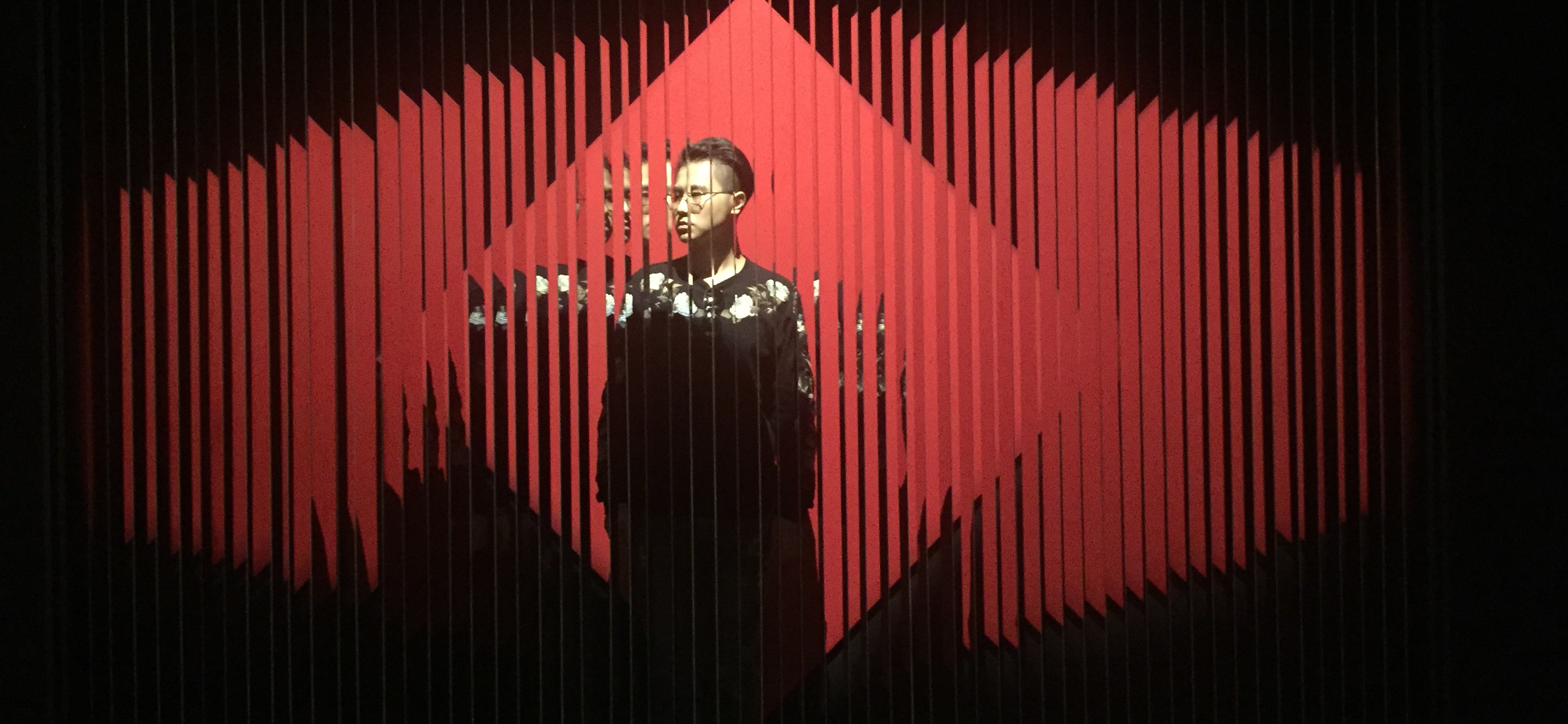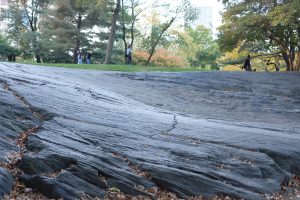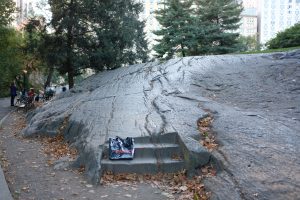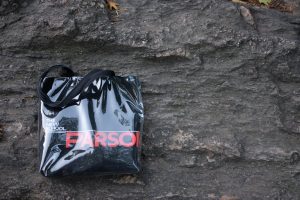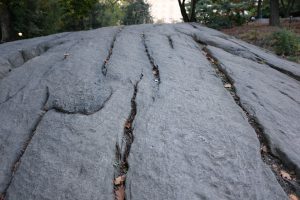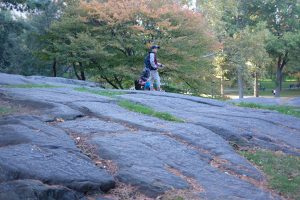1) Independently complete Central Park observations + project (post responses to the prompts #1-5 on your LP + your poetic project and caption paragraph). To visit the stone steps and outcropping of rock that Robert Smithson photographed, enter the park at 6th Avenue and 59th street, veering slightly to the left when entering the park. Use the reference image of the Essex House (on your print out) to find the location.
THINK ABOUT CHANGE: Imagine yourself in Central Park one million years ago. You would be standing on a vast ice sheet, a 4,000-mile glacial wall, as much as 2,000 feet thick. Alone on the glacier, you would not sense its slow crushing, scraping, ripping movement as it advanced south, leaving great masses of rock debris in its wake. Under the frozen depths, where the carousel now stands, you would not notice the effect on the bedrock as the glacier dragged itself along.” – artist Robert Smithson, 1972
HYPOTHESIS TO TEST: We are living in within an age of climate change
DATA GATHERING: Make aesthetic and scientific observations + data collection:
LOOK AT AND CONSIDER WHAT IS HERE: the steps carved as a poetic human affordance in the Manhattan schist (450 million years old), the glacial scraping still visible on the rock (several thousand years old), to the materials that compose the surrounding buildings (150 years-present).
PAUSE to consider the massive planetary changes, both human and geologic, that have occurred to melt the ice (that would have towered nearly a mile above you) and have afforded the urban park and cityscape surrounding you today.
OBSERVE AND MAKE CONTACT with the layers of history materially present today. Look closely at the Manhattan schist steps (450 million years old). Touch the glacial scrapes still visible on the rock (several thousand years old) and study the surrounding buildings and park design (150 years-present). Listen. Smell. Observe what is human made here and what is “natural”? What sights, sounds, smells, structures and materials around you provide “evidence” of the Anthropocene? What species of species of plants and animals do you see? How many people? What kind of designs and infrastructure? What kind of “garbage”?
Answer the following (post later to your LP):
1) What does it feel like knowing that so much ice used to be here, but is now gone? Is it hard or easy to imagine this site being so different?
It’s quite hard to image that New York city use to be an ice land. I think this place must have took a series of long-term climate change before becoming today’s New York. And I also feel that the impact of human on New York today is much greater and faster than the impact of nature.
2) What sights, sounds, smells, structures and materials around you provide evidence of the Anthropocene?
Although Central Park is a natural land, but here is surrounded by a lot of unnatural elements. I can see a lot of people, but also hear a lot of noise, there are few of garbage in the bushes. The smell around is very complicated, not only the smell of the woods, but also the smell of food and even the smell of horse manure.
3) Do you feel like you have contributed to material realities that indicate the arrival of the Anthropocene? How/why/when?
Yes, I think every human have contributed to material realities that indicate the arrival of the Anthropocene. Because every unnatural product we use and every unnatural activity we did all make the great contribution.
4) Do you think the public should be aware of the Anthropocene?
Yes, I think so. But it’s really difficult to achieve. When everyone has a sense of Anthropocene, the impact of human beings on the environment may be able to get better.
5) What kind of climates do you think are possible in New York City’s future?
I think the weather in New York will be more volatile and extreme climates may become more and more.
I produced a poster that directly showed the central park area from the glacier era to the present.
Create a poetic work using the observations you gather in Central Park (words, original photography, drawings, sound recordings, and/or found objects) to aesthetically express the transition in climate that has unfolded in this spot over the past 10,000 years. A glacier, the urban city we see today — and an uncertain climate future. This can be a poem, a text/image piece, a drawing or an audio/video piece. Please post this on your LP with a paragraph describing what you made and why.
I produced a poster that directly showed the central park area from the glacier era to the present.
I made this post because I think the process of New York from the glacier zone into today’s look like this is amazing. I want to restore the most intuitive visual experience to people of this process. And make them to think by themselves about the how big change of New York’s climate.
2) List three design/object ideas + sketches for your final project. Describe each idea, thinking through what you think will need and use over the next fifty years, given what you have learned in this class (a result of the great acceleration/climate change)? Describe how each of these designs/objects/ideas would help you (or make your life more easy, beautiful, useful etc.)? How might these ideas might meet the Long Life Design criteria? What systems and materials are they reliant upon in order to exist? Are these systems threatened by climate change?
- I want to design a raincoat, the use of thin pvc fabric, so that people can wear all year round. The raincoat function is waterproof and does not need to be considered warm or breathable. I will use minimalist style, so that it can be with any kind of style clothes, it will not conflict with other styles. The life of this design will be much longer than the average clothes.
- I want to design a printer that allows users to add their own ink. Because all the current printer manufacturers to profit, put the printer’s cartridge design cannot be refill. And even use the counting chip, automatic scrapped ink cartridges. They do so in order to allow users to continue to buy new cartridges, so the company can continue to profit. But the process of producing ink cartridges is extremely unfriendly to the environment. So I would like to design a printer to encourage users to add their own ink or ink cartridges.
- Modular electronic equipment. Many manufacturers are still in order to profit, they design the electronic equipment as an irreplaceable. I would like to use the modular design concept and create the modular electronic equipment. This design can encourage users to replace damaged parts in a simpler way, rather than discarding the entire product and buy new ones.
